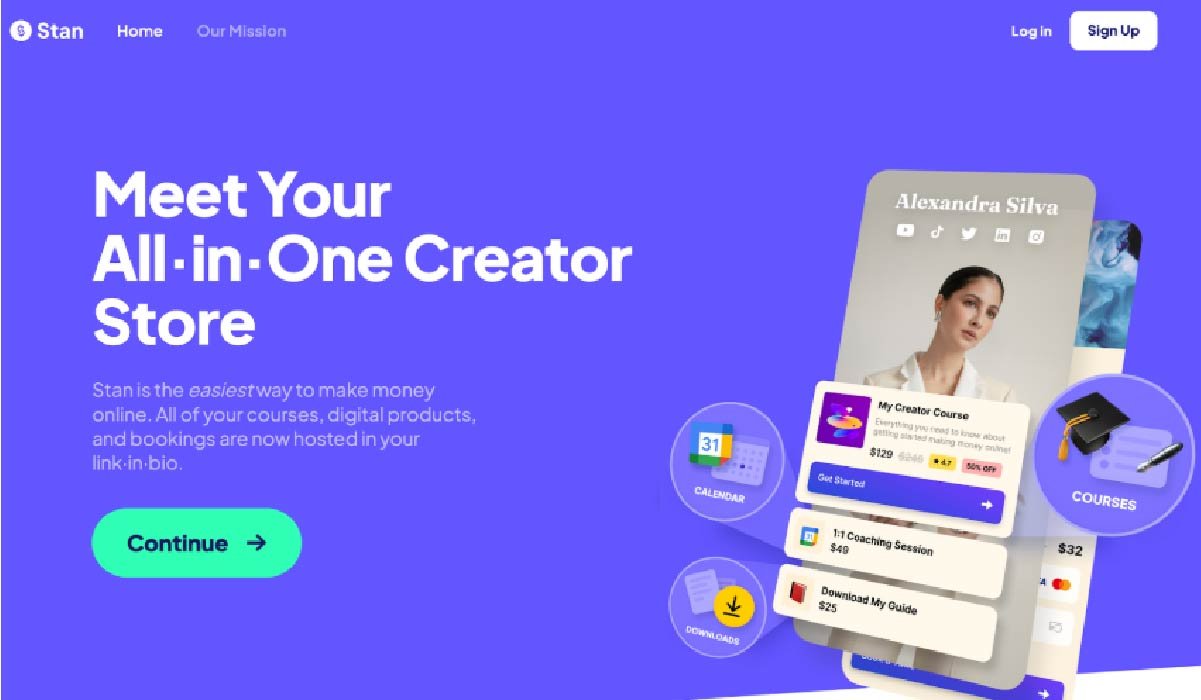Tech
The Creator Economy Revolution: Building Sustainable Revenue Streams in the Digital Age

The creator economy has evolved from a niche hobby pursuit into a multi-billion dollar industry that’s reshaping how individuals build careers, generate income, and connect with audiences worldwide. This transformation has created unprecedented opportunities for talented individuals to monetize their skills, knowledge, and creativity without traditional gatekeepers or corporate intermediaries. From social media influencers to educational content creators, artists to business coaches, millions of people are discovering that their unique perspectives and abilities can translate into sustainable, profitable ventures. The proliferation of creator-focused platforms has democratized entrepreneurship, enabling anyone with valuable content or services to build thriving businesses. Understanding the landscape of available tools and platforms, including options like Stan Store, has become essential for creators serious about turning their passions into profitable enterprises that can support their lifestyle goals and creative ambitions.
The Foundation of Creator Economy Success
Building a successful creator business requires understanding the fundamental principles that separate thriving creators from those who struggle to generate meaningful revenue. The creator economy operates on different principles than traditional employment or business models, requiring creators to master multiple disciplines simultaneously while maintaining authentic connections with their audiences. This complexity has led to the development of specialized tools and platforms designed to simplify the business aspects of content creation.
Successful creators consistently demonstrate several key characteristics that contribute to their financial success. They understand their audience deeply, create consistent value through their content or services, and maintain professional standards in their business operations. They also recognize that monetization is not just about selling products or services, but about building sustainable relationships with supporters who believe in their mission and want to contribute to their success.
The democratization of content creation tools and distribution platforms has lowered barriers to entry significantly, enabling creators to reach global audiences without significant upfront investments. However, this accessibility has also increased competition, making it essential for creators to differentiate themselves through unique value propositions, exceptional quality, and strategic business planning.
Platform dependency has emerged as a critical risk factor for many creators who build their entire businesses on social media algorithms or third-party platforms beyond their control. Successful creators diversify their revenue streams and maintain direct relationships with their audiences through email lists, personal websites, and owned platforms that provide greater control over their business operations and customer relationships.
Diversifying Revenue Streams for Long-term Stability
The most successful creators understand that relying on a single revenue source creates vulnerability and limits growth potential. Diversification strategies enable creators to weather algorithm changes, platform policies, economic downturns, and shifting audience preferences while building multiple pathways to profitability. This approach requires strategic planning and systematic implementation of various monetization methods that complement each other and serve different audience segments.
Digital product sales represent one of the most scalable revenue streams for creators, enabling them to package their knowledge, skills, or creativity into products that can be sold repeatedly without ongoing time investment. These products might include online courses, ebooks, templates, software tools, or digital artwork that provides value to specific audience segments while generating passive income for creators.
Service-based offerings provide higher-value revenue opportunities through consulting, coaching, done-for-you services, or custom creative work. While these offerings require more time investment per transaction, they often command premium pricing and create deeper relationships with clients who may become long-term supporters and referral sources.
Membership and subscription models create predictable recurring revenue that enables creators to plan and invest in their businesses more confidently. These models work particularly well for creators who produce regular content, provide ongoing value through community access, or offer exclusive resources that justify monthly or annual fees.
Affiliate marketing and strategic partnerships enable creators to earn commissions by promoting products or services they genuinely use and recommend. Successful affiliate marketing requires alignment between promoted products and audience needs, maintaining transparency about affiliate relationships, and focusing on long-term trust rather than short-term commissions.

Understanding Creator Platform Ecosystems
The creator platform landscape has exploded with options designed to serve different needs, audience types, and monetization strategies. Understanding the strengths and limitations of various platforms helps creators make informed decisions about where to invest their time and energy. Each platform offers unique features, fee structures, and audience characteristics that influence their suitability for different creator goals and business models.
All-in-one creator platforms have gained popularity by consolidating multiple business functions into single solutions that simplify operations for busy creators. These platforms typically include features for content hosting, audience management, payment processing, and analytics, reducing the technical complexity of running a creator business while providing integrated experiences for both creators and their supporters.
Specialized monetization tools focus on specific aspects of creator business operations, such as fan funding, digital product sales, or community management. These tools often provide deeper functionality in their focus areas compared to all-in-one solutions, making them attractive for creators with specific needs or those who prefer to customize their technology stack.
Social commerce integration has become increasingly important as creators seek to monetize their existing social media audiences directly without requiring followers to navigate to separate platforms. This integration reduces friction in the purchasing process while enabling creators to leverage their established social media presence for direct sales.
The emergence of innovative monetization models continues to expand possibilities for creator revenue generation. Understanding newer concepts and platforms, such as exploring what is Passes, helps creators stay current with evolving opportunities and identify monetization methods that align with their content style and audience preferences.
Building Authentic Audience Relationships
The foundation of sustainable creator economy success lies in building genuine, trust-based relationships with audiences who value the creator’s unique perspective and offerings. This relationship-building process requires consistent authenticity, valuable content delivery, and genuine care for audience needs rather than purely transactional interactions. Creators who prioritize relationship-building over quick monetization typically achieve better long-term results and higher customer lifetime values.
Content consistency plays a crucial role in audience relationship development, demonstrating reliability and commitment that audiences can depend upon. This consistency extends beyond posting schedules to include quality standards, brand voice, and value delivery that audiences learn to expect and appreciate. Consistent creators build anticipation and loyalty that translates into stronger monetization opportunities.
Community building transforms passive audiences into active participants who contribute to the creator’s ecosystem through engagement, word-of-mouth marketing, and direct financial support. Successful community building requires creating spaces where audience members can connect with each other as well as the creator, fostering relationships that extend beyond the creator’s content to include peer-to-peer value exchange.
Transparency and authenticity have become non-negotiable requirements for creators who want to build lasting audience relationships. Modern audiences are sophisticated and can easily detect inauthentic behavior or purely profit-driven motivations. Creators who share their journeys honestly, including challenges and failures, often build stronger connections than those who present only polished success stories.
Value-first approaches prioritize audience benefit over immediate monetization, creating goodwill and trust that supports long-term business success. Creators who consistently provide free value demonstrate their expertise and commitment to audience success, making paid offerings feel like natural extensions of their helpful relationship rather than aggressive sales tactics.
Technology and Tools for Creator Success
The technological infrastructure supporting creator businesses has become increasingly sophisticated, providing powerful tools that enable individual creators to operate with capabilities previously available only to larger organizations. Understanding and strategically implementing these tools can significantly amplify creator productivity, reach, and revenue potential while reducing operational complexity and time investment.
Content management systems designed specifically for creators provide streamlined workflows for content creation, editing, publishing, and distribution across multiple channels. These systems often include collaboration features, version control, and automated publishing capabilities that help creators maintain consistent output while managing complex content calendars and multiple platform requirements.
Customer relationship management tools help creators organize and nurture their audience relationships systematically, tracking interactions, preferences, and purchase history to enable personalized communication and targeted marketing efforts. These tools become increasingly valuable as creator audiences grow and direct personal interaction with every supporter becomes impossible.
Analytics and performance tracking tools provide insights into content performance, audience behavior, and revenue patterns that inform strategic decision-making. Successful creators use these insights to optimize their content strategies, identify their most valuable audience segments, and allocate resources toward activities that generate the best returns on investment.
Payment processing and financial management tools specifically designed for creator businesses address unique needs such as international payments, subscription billing, affiliate commission tracking, and tax reporting. These specialized tools often provide better creator-focused features and support compared to generic business payment solutions.
Email marketing and automation platforms enable creators to maintain direct communication with their audiences independent of social media algorithms or platform policies. Email remains one of the highest-converting marketing channels for creators, making sophisticated email marketing capabilities essential for serious creator businesses.

Monetization Strategy Development
Developing effective monetization strategies requires understanding audience needs, creator strengths, and market opportunities while considering long-term sustainability and growth potential. Successful creators typically evolve their monetization strategies over time, starting with simpler approaches and gradually introducing more sophisticated revenue streams as their businesses mature and audiences grow.
Market research and audience analysis form the foundation of effective monetization strategy development, helping creators understand what their audiences value most and are willing to pay for. This research might include surveys, social media engagement analysis, competitor research, and direct audience feedback that reveals monetization opportunities aligned with audience needs.
Pricing strategy development requires balancing accessibility for supporters with adequate revenue generation for business sustainability. Creators must consider their audience demographics, perceived value of their offerings, competitive landscape, and business goals when setting prices that maximize both revenue and audience satisfaction.
Launch strategy planning ensures that new monetization initiatives receive adequate promotion and support to achieve their potential success. Successful launches typically include pre-launch audience education, limited-time incentives, social proof development, and systematic follow-up that maximizes conversion rates and creates momentum for ongoing sales.
Performance measurement and optimization enable creators to refine their monetization approaches based on actual results rather than assumptions. This data-driven approach helps creators identify their most profitable activities, eliminate underperforming initiatives, and continuously improve their revenue generation effectiveness.
Platform Comparison and Selection Criteria
Choosing the right platforms for creator business operations requires careful evaluation of features, costs, audience fit, and long-term strategic alignment. The platform landscape continues to evolve rapidly, with new entrants regularly introducing innovative features and established platforms updating their offerings to remain competitive. Creators must balance immediate needs with future growth plans when making platform decisions that will influence their business operations significantly.
Feature comparison should focus on capabilities that directly impact creator business goals rather than impressive feature lists that may not provide practical value. Essential features typically include payment processing reliability, customization options, audience management capabilities, analytics quality, and integration possibilities with other tools in the creator’s technology stack.
Cost analysis must consider both obvious expenses like transaction fees and subscription costs, and hidden costs such as time investment for platform learning, migration costs if switching becomes necessary, and opportunity costs of choosing platforms with limited growth potential. Total cost of ownership analysis provides more accurate platform comparison than focusing solely on upfront expenses.
Audience alignment evaluation considers whether platform user bases match creator target demographics and behavior patterns. Platforms with engaged, creator-supportive audiences often provide better results than those with larger but less engaged user bases or audiences that don’t align with creator offerings and pricing strategies.
Growth and scalability assessment examines platform capabilities to support creator business expansion over time. Platforms that work well for beginning creators may have limitations that become problematic as businesses grow, making long-term platform selection crucial for creators with ambitious growth goals.
Integration capabilities determine how well platforms work with other tools in creator technology stacks, influencing operational efficiency and data management effectiveness. Platforms with robust integration options typically provide more flexibility and long-term value than isolated solutions that require manual data transfer and duplicate effort.
Emerging Trends and Future Opportunities
The creator economy continues to evolve rapidly, with new trends, technologies, and opportunities emerging regularly that savvy creators can leverage for competitive advantages. Staying informed about these developments helps creators position themselves advantageously while avoiding investments in declining or unsustainable approaches that could waste resources and limit growth potential.
Artificial intelligence integration is beginning to transform creator workflows through automated content creation, audience analysis, personalized recommendations, and operational efficiency improvements. Creators who learn to leverage AI tools effectively can significantly amplify their productivity while maintaining the authentic human connections that audiences value.
Blockchain and cryptocurrency technologies are creating new monetization possibilities through NFTs, creator coins, decentralized platforms, and direct fan funding mechanisms. While these technologies remain experimental and volatile, they represent potential opportunities for creators willing to explore innovative monetization approaches with appropriate risk management.
Virtual and augmented reality platforms are opening new content formats and audience experiences that could create significant opportunities for creators who adapt early to these emerging mediums. As VR/AR adoption increases, creators with experience in these formats may have significant advantages in reaching and monetizing new audience segments.
Community ownership models are gaining traction, with platforms exploring ways to give creators and audiences ownership stakes in the platforms they help build. These models could fundamentally change creator-platform relationships by aligning long-term interests and providing creators with greater control over their business environments.
The expansion into international markets presents opportunities for creators to reach global audiences through improved translation technologies, cross-border payment solutions, and cultural adaptation tools. Creators who successfully expand internationally often discover significantly larger addressable markets and diverse revenue opportunities. Understanding emerging platforms and their unique positioning, such as researching what is Fanfix and its specific creator-focused features, helps creators evaluate new opportunities and make informed decisions about platform adoption and audience expansion strategies.
Frequently Asked Questions
Q: How much money can creators realistically expect to earn when starting out? A: Creator earnings vary dramatically based on niche, audience size, monetization methods, and business approach. Most creators earn little to nothing in their first months, with successful creators typically seeing meaningful income after 6-12 months of consistent effort. Focus on providing value and building audience rather than immediate income expectations.
Q: What’s the most important factor for creator success in monetization? A: Audience trust and value delivery are the most critical factors. Creators who consistently provide value and maintain authentic relationships with their audiences typically succeed regardless of specific platforms or monetization methods. Technical skills and business knowledge can be learned, but audience trust must be earned over time.
Q: Should creators focus on one platform or diversify across multiple platforms? A: Most successful creators recommend starting with one primary platform to build initial audience and expertise, then gradually expanding to additional platforms. Diversification reduces platform risk, but spreading efforts too thin early can limit growth on any single platform.
Q: How do creators handle taxes and business finances? A: Creator businesses should be treated as legitimate businesses with proper bookkeeping, tax planning, and legal structure consideration. Many creators benefit from working with accountants familiar with creator economy tax issues and business structures that optimize for their specific situations.
Q: What are the biggest mistakes new creators make when trying to monetize? A: Common mistakes include monetizing too early before building audience trust, copying other creators’ strategies without considering audience fit, focusing on quick money rather than long-term value creation, and neglecting business fundamentals like customer service and financial management.
Q: How important is it to have a unique niche versus broader appeal? A: Niche focus typically provides better results for creators starting out, as it’s easier to become known for specific expertise and attract dedicated audiences. Broader appeal can work but usually requires more resources and time to achieve meaningful traction.
Q: What legal considerations should creators be aware of? A: Creators should understand intellectual property rights, disclosure requirements for sponsorships and affiliate relationships, contract basics for collaborations, and privacy regulations that affect audience data collection. Consulting with attorneys familiar with creator economy issues can prevent costly mistakes.
The creator economy represents one of the most significant economic shifts of the digital age, providing unprecedented opportunities for individuals to build sustainable businesses around their passions and expertise. Success in this environment requires combining creative skills with business acumen, audience relationship building with strategic monetization, and authentic value creation with professional operations. As the creator economy continues to mature and evolve, those who approach it with strategic thinking, consistent effort, and genuine commitment to audience value will find the greatest opportunities for long-term success and fulfillment.
-

 Celebrity1 year ago
Celebrity1 year agoWho Is Jennifer Rauchet?: All You Need To Know About Pete Hegseth’s Wife
-

 Celebrity1 year ago
Celebrity1 year agoWho Is Mindy Jennings?: All You Need To Know About Ken Jennings Wife
-

 Celebrity1 year ago
Celebrity1 year agoWho Is Enrica Cenzatti?: The Untold Story of Andrea Bocelli’s Ex-Wife
-

 Celebrity1 year ago
Celebrity1 year agoWho Is Klarissa Munz: The Untold Story of Freddie Highmore’s Wife
















